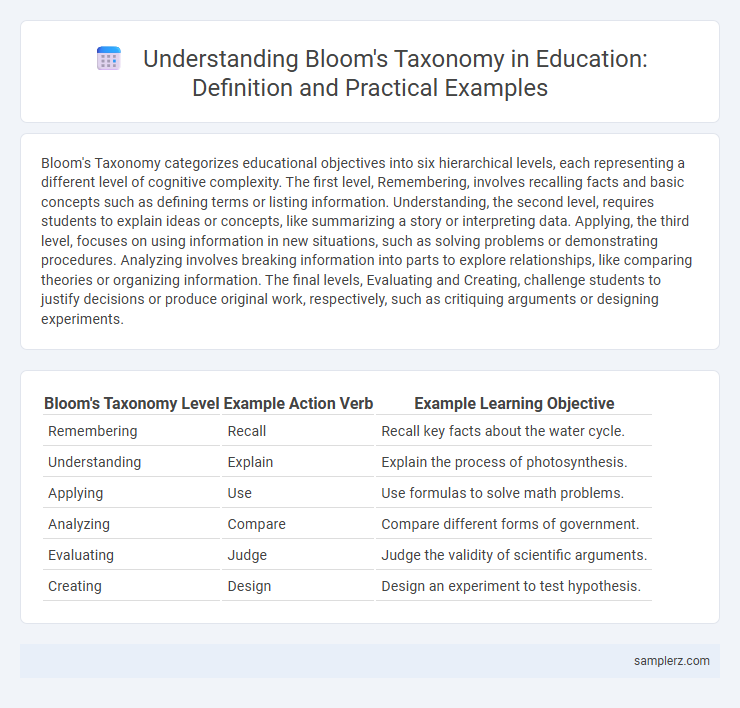Bloom's Taxonomy categorizes educational objectives into six hierarchical levels, each representing a different level of cognitive complexity. The first level, Remembering, involves recalling facts and basic concepts such as defining terms or listing information. Understanding, the second level, requires students to explain ideas or concepts, like summarizing a story or interpreting data. Applying, the third level, focuses on using information in new situations, such as solving problems or demonstrating procedures. Analyzing involves breaking information into parts to explore relationships, like comparing theories or organizing information. The final levels, Evaluating and Creating, challenge students to justify decisions or produce original work, respectively, such as critiquing arguments or designing experiments.
Table of Comparison
| Bloom's Taxonomy Level | Example Action Verb | Example Learning Objective |
|---|---|---|
| Remembering | Recall | Recall key facts about the water cycle. |
| Understanding | Explain | Explain the process of photosynthesis. |
| Applying | Use | Use formulas to solve math problems. |
| Analyzing | Compare | Compare different forms of government. |
| Evaluating | Judge | Judge the validity of scientific arguments. |
| Creating | Design | Design an experiment to test hypothesis. |
Understanding Bloom's Taxonomy: A Brief Overview
Bloom's Taxonomy categorizes cognitive skills into six levels, starting with Remembering and progressing to Understanding, Applying, Analyzing, Evaluating, and Creating. The Understanding level emphasizes comprehension of concepts, requiring learners to interpret, summarize, and explain information in their own words. Examples at this stage include explaining the main idea of a text, interpreting data from a graph, and summarizing key points from a lecture.
Examples of Bloom’s Taxonomy in Lesson Planning
Lesson planning incorporating Bloom's Taxonomy involves structuring objectives across cognitive levels such as Remembering, Understanding, Applying, Analyzing, Evaluating, and Creating. For instance, a science lesson might begin with recalling key terms (Remembering), explaining concepts in students' own words (Understanding), conducting experiments to apply hypotheses (Applying), comparing results to identify patterns (Analyzing), critiquing methodology for validity (Evaluating), and designing new experiments (Creating). This framework ensures comprehensive cognitive development and measurable learning outcomes.
Applying Bloom’s Taxonomy: Classroom Scenarios
Applying Bloom's Taxonomy in classroom scenarios involves designing activities where students demonstrate their understanding by applying concepts to real-world situations, such as solving math problems using formulas or conducting science experiments based on hypotheses. This approach enhances critical thinking and retention by encouraging learners to actively engage with the material beyond memorization. Educators can measure comprehension effectively by assigning projects that require analysis, synthesis, and practical implementation of knowledge.
Real-Life Activities Aligned with Bloom’s Levels
Analyzing financial statements in a business internship exemplifies Bloom's higher-order cognitive skill of analysis, facilitating the application of theoretical knowledge in real-life contexts. Designing a community garden project engages synthesis by encouraging students to combine concepts from biology, environmental science, and social studies. Participating in peer teaching sessions promotes evaluation, as students must assess their understanding and provide constructive feedback.
Sample Questions for Each Level of Bloom’s Taxonomy
Sample questions for Bloom's Taxonomy target cognitive skill development at each level: Remember questions ask students to recall facts, such as "What is photosynthesis?" Understand prompts comprehension with questions like "Explain the process of photosynthesis in plants." Apply requires using knowledge practically, e.g., "How would you use photosynthesis principles to grow a plant indoors?"
Bloom’s Taxonomy Examples in Assessments
Bloom's Taxonomy in assessments categorizes cognitive skills into six levels: Remembering, Understanding, Applying, Analyzing, Evaluating, and Creating. Examples include asking students to recall facts (Remembering), explain concepts in their own words (Understanding), solve problems using learned methods (Applying), differentiate between theories (Analyzing), critique arguments (Evaluating), and design original projects or experiments (Creating). These levels guide educators in developing diverse assessment tasks that measure various depths of student learning and ensure comprehensive evaluation.
Creating Learning Objectives Using Bloom’s Taxonomy
Creating learning objectives using Bloom's Taxonomy involves structuring goals that target cognitive skills at various levels, from Remembering to Creating. For example, a learning objective at the Creating level might be: "Students will design an original marketing campaign that integrates core principles of consumer behavior." This approach ensures objectives promote higher-order thinking and encourage students to synthesize and apply knowledge creatively.
Integrating Bloom’s Taxonomy in Curriculum Design
Integrating Bloom's Taxonomy in curriculum design involves structuring learning objectives across cognitive levels such as Remembering, Understanding, Applying, Analyzing, Evaluating, and Creating to promote higher-order thinking skills. Educators use Bloom's framework to align assessment methods and instructional activities with targeted cognitive processes, ensuring a comprehensive learning experience. Incorporating this taxonomy helps in developing critical thinking and problem-solving abilities by gradually advancing the complexity of tasks within the curriculum.
Differentiating Instruction with Bloom’s Taxonomy
Differentiating instruction with Bloom's Taxonomy involves tailoring teaching strategies to address various cognitive levels, such as applying, analyzing, and evaluating. Educators design activities that promote critical thinking by encouraging students to compare concepts, categorize information, and justify decisions. This approach enhances student engagement and supports diverse learning needs by targeting specific cognitive skills within Bloom's hierarchical framework.
Evaluating Student Progress Using Bloom’s Taxonomy
Evaluating student progress using Bloom's Taxonomy involves assessing higher-order thinking skills such as analysis, evaluation, and creation to measure deeper understanding. Teachers utilize rubrics aligned with Bloom's levels to gauge students' abilities in critiquing arguments, solving complex problems, and generating original ideas. This structured evaluation framework enhances feedback precision and supports targeted instructional strategies for academic growth.

example of bloom in taxonomy Infographic
 samplerz.com
samplerz.com